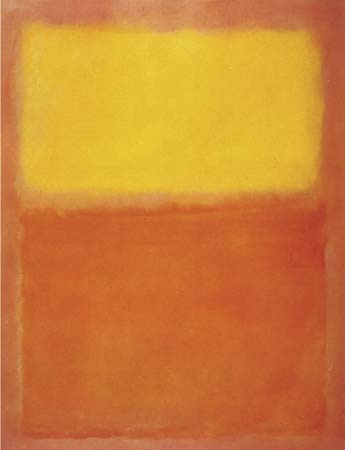colour-field painting
art
also called post-painterly abstraction
with Action painting, one of two major strains of the 20th-century art movement known as Abstract Expressionism. The term typically describes large-scale canvases dominated by flat expanses of colour and having a minimum of surface detail. This strain was identified in the mid-1950s by the American art critic Clement Greenberg, who used the term “post-painterly abstraction” to describe the work of a group of painters including Morris Louis (Louis, Morris), Helen Frankenthaler (Frankenthaler, Helen), and Kenneth Noland (Noland, Kenneth).
 In his influential essay "Modernist Painting" (1961), Greenberg articulated the idea that painting should be self-critical, addressing only its inherent properties—namely, flatness and colour. He declared that “Modernism used art to call attention to art,” and in his writings of this period he traced the lineage of colour-field painting back to the unmodulated figure rendering in Édouard Manet (Manet, Édouard) through the large abstractions of Mark Rothko (Rothko, Mark) and Barnett Newman (Newman, Barnett). Colour-field paintings typically have a unified, single-image field and differ qualitatively from the gestural, expressive brushwork of such artists as Jackson Pollock (Pollock, Jackson) and Willem de Kooning (de Kooning, Willem).
In his influential essay "Modernist Painting" (1961), Greenberg articulated the idea that painting should be self-critical, addressing only its inherent properties—namely, flatness and colour. He declared that “Modernism used art to call attention to art,” and in his writings of this period he traced the lineage of colour-field painting back to the unmodulated figure rendering in Édouard Manet (Manet, Édouard) through the large abstractions of Mark Rothko (Rothko, Mark) and Barnett Newman (Newman, Barnett). Colour-field paintings typically have a unified, single-image field and differ qualitatively from the gestural, expressive brushwork of such artists as Jackson Pollock (Pollock, Jackson) and Willem de Kooning (de Kooning, Willem).The notion of colour-field painting implied that only optical responses were significant in painting. Subject matter was forbidden and illusionism condemned. Frankenthaler (Frankenthaler, Helen)'s stained paintings perfectly embodied Greenberg's formalist direction by making surface and colour inseparable. She literally soaked the unprimed canvas with pigment, creating fields of amorphous colour. Inspired by Frankenthaler's stained paintings, Morris Louis (Louis, Morris) began soaking his canvases in the late 1950s. He also eliminated the brushstroke altogether by pouring viscous lines of multicoloured paint to create rainbow effects. Like Jasper Johns (Johns, Jasper) before him, Noland used the banal target as a found design with which to examine different hues and values of flat colour.
Additional Reading
Jonathan Fineberg, Art Since 1940: Strategies of Being, 2nd ed. (2000); Clement Greenberg, Art and Culture: Critical Essays (1961, reissued 1989); Edward Lucie-Smith, Movements in Art Since 1945, 3rd rev. and expanded ed. (1995).
- Carbon in Earth's crust
- carbonium ion
- carbon monoxide
- carbon monoxide poisoning
- carbon steel
- carbon tetrachloride
- carbonyl group
- carborane
- carboxylic acid
- carbuncle
- carburetor
- carburizing
- Carcassonne
- carcharhinid
- Carchemish
- carcinogen
- carcinoma
- cardamom
- Cardamom Hills
- Cardano, Girolamo
- Cardarelli, Vincenzo
- Cardenal, Ernesto
- Cardenal Jiménez de Cisneros, Francisco
- card game
- cardiac catheterization